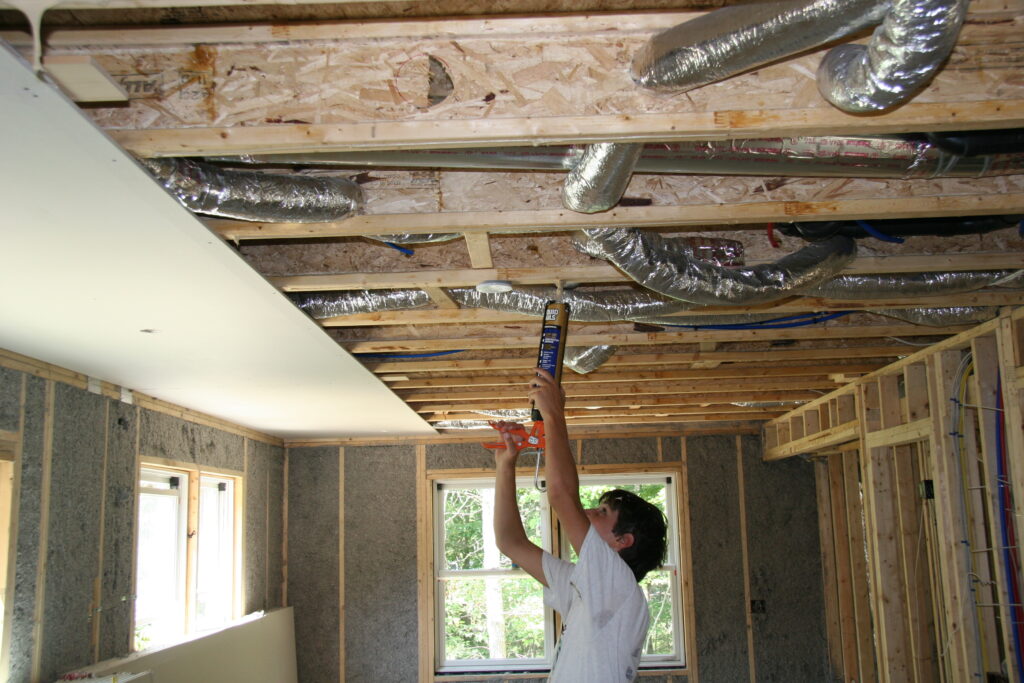Drywall Adhesive?
By Myron Ferguson

I have no idea how many contractors are using drywall adhesive. I see the adhesive sold everywhere and I see some real benefits, so I think quite a few. Typically one large tube of adhesive will adhere about 500 sq ft of drywall so the cost for most homes is well under $100. I typically charge about $250 extra to use drywall adhesive. I know this is way too cheap but read further and you will understand why I am tempted to use adhesive even If I was not being paid extra.
I have an older AWCI publication from 1996 that is titled “Recommended Guide for Methods of Gypsum Board Attachment” That is around the time that I started using drywall adhesive. This is what is stated in the document.
“Adhesive and Supplemental Screws”
“Use a drywall adhesive complying with ASTM C 557. Apply a single 3/8” bead over all framing members that occur in the field and double bead where joints occur. Work within the “open time” of adhesive and press board tight to framing before setting screws. This is a superior method of attachment that develops excellent shear strength, reduces potential for bowing or sagging and eliminates nail pops.”
There is also a chart that says that with adhesive walls can be screwed 24” o. c. and ceilings 16” o. c.
Keep in mind that for fire, sound, and structural designs specific construction details must be followed. For example for a fire assembly the number of screws used may not be able to be reduced and for sound control drywall adhesive could actually enhance sound vibrations.
I think it is also important to note that the adhesive has to comply with ASTM 557. This means that not just any old adhesive or caulk will do the job. I spoke to some drywall manufacturers about using drywall adhesive and they did not want to endorse the use of drywall adhesive, not because they did not think it was a helpful idea but because they had no control over whether the installers were using the right adhesive and applying it correctly.
Some drywaller’s have complained that the building inspector will not pass the drywall inspection if less screws are used, so what is the point? This is a valid question because now the hangers have to install all the screws and the adhesive as well. They are going to charge more to hang the drywall.
I have talked to some builders who say adhesive is unnecessary because they have very few screw pops and I have to admit that I never really had a problem with screw pops. But it does not take many screw pops for the customer to think there is a problem. When the full number of screws are used there is about one screw for every square foot of drywall. So, on a job where 10,000 sq ft of drywall is hung that is about 10,000 screws. How many screw pops is your customer going to allow? I expect a phone call if there are only 12 screw pops on the whole job.
If no drywall adhesive is used the screw pops are usually noticed and corrected during the taping and sanding process. I have found that when drywall adhesive is used I really don’t have any screw pops to fix while taping. This a big time saver and now I don’t even expect those 12 pops later on and I avoid having to came back and do the repairs. Money saved and no callbacks!!
I do realize that applying the adhesive is not much fun, there is the dripping off ceilings, the caulk guns that don’t work or barely work (why is it that something with two moving parts can be so unreliable?), the busted tubes, and remembering to apply the adhesive when it is too late. I have been using the battery powered caulk guns for years and I like them because it is easier. I recently used the expanded foam adhesive. The can fit right into my foam gun, was easy to apply because I just had to hold the trigger open, and one can went a long way.
Of course there are some instances where drywall adhesive can’t be used. For example if poly has been attached to the walls for a vapor retarder, when cellulose insulation with the mat has been used, and if framing is dusty because of expanded foam that was scraped off.
As I said I prefer that the adhesive is applied and the crews I occasionally use to hang drywall have adapted to using it so it now longer slows them down at all.
